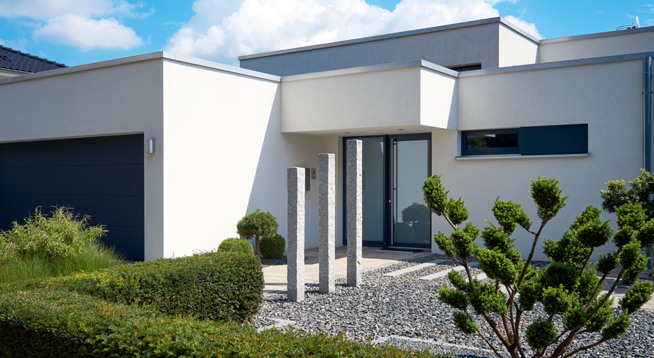
By Ken Calverley and Chuck Breidenstein
DETROIT, November 24, 2022 ~ You’ve heard “The Guys” for years saying that any building needs a great roof and a great foundation.
But in that discussion, we have ignored a huge segment of the roofing market: flat roofs.
According to the National Roofing Contractors Association, NRC, a flat roof has a slope of 3 inches vertical to 1 horizontal or less.
Flat roofs are almost never actually flat and instead have a typical slope of ¼ to ½ inch of vertical fall to each 12 inches of horizontal run.
Many such roofs will simply have a consistent slope to the rear of a building where they will either deposit runoff water directly to the ground at the base of the building or will direct water to a large gutter which will take the water away from the building.
Other flat roofs direct water to roof sumps or sinks which are grates covering pipes tied to the building’s storm water system.
It is estimated there are approximately 2,000 square miles of roof area in the United States, with commercial flat roofs comprising roughly ⅓ of that area.
Why build a flat roof?
PODCASTS:
November 26, 2022 ~ Chuck “The Inside Guy” Breidenstein and Ken “The Outside Guy” Calverly offer the knowledge and tools you need to make the home of your dreams a reality. Catch them every Saturday and Sunday from 10 a.m. to noon on 760 WJR.
(CONTINUED) One must consider the complete system to understand that flat roofs are typically less expensive to build than sloped roofs. Sloped roofs create more square footage of surface area and thus require more materials.
The aesthetic of a commercial building does not usually demand the visual weight, texture and color of a sloped roof.
Many commercial building roofs will also support equipment used for conditioning air and it is an easier assembly to support and service that equipment on a flat roof.
The largest segment of the flat roof market is Built Up Roof, BUR, systems which are often comprised of two to four layers of bitumen impregnated fiber sheets, think tarpaper, “mopped” into a monolithic cover with modified liquid tar.
This system will often be covered with a light-colored stone to provide a wear surface and ballast to resist uplift caused by winds. The stone can be walked upon if needed and it is both reflective and absorptive providing protection from the sun.
The industry is rife with various products, each with their own acronym, like PVC, TPO, EPDM and more.
Most of these are a type of synthetic rubber sheet with various characteristics including thickness, generally from thirty to sixty mils, strength, weight, ease of installation, reflective capabilities, longevity and cost.
Like shingles for sloped roofs, there is different product for different need. One advantage of the PVC, poly-vinyl-chloride, product is that it can withstand the abuse of heavy equipment and foot traffic to 350 pounds per square inch.
PVC is one of the better such products available and is, expectedly, near the top of the pricing structure.
A lot of these systems, with proper installation and maintenance, can last 30 years and, in some cases, even a decade or two longer.
A downside to flat roof systems can be locating leaks before they cause too much damage.
Roof sumps, blocked by debris, may create water head or weight through backups which might force water into small holes or penetrations.
Because these roofs may lay over a layer or two of rigid foam insulation, leaks may not manifest early or anywhere near where they are occurring.
Bill Burkhardt Jr., vice president of sales and marketing for Four Seasons Kanga Roofing in Roseville, tells us that infrared scans are not only a great tool for detecting active leaks, but can be used for routine maintenance inspections.
Burkhardt’s company routinely installs flat roof systems for commercial property owners throughout the metro area.
His contention is that it is not a “one-size-fits-all” solution, so Four Seasons Kanga offers a variety of systems they are expert at and, in Burkhardt’s words, installed systems they can warranty and service on behalf of their clients.
For those low-profile residential roofs, there is also the option of aluminum or steel roofing materials.
Keep in mind that there are many products and systems available. The trick is to find the right professional with trained personnel, a proven track record and a great warranty, like the people you can find at InsideOutsideGuys.com.
For housing advice and more, listen to “The Inside Outside Guys” every Saturday and Sunday on 760 WJR, from 10 a.m. to noon, or contact us at InsideOutsideGuys.com.





